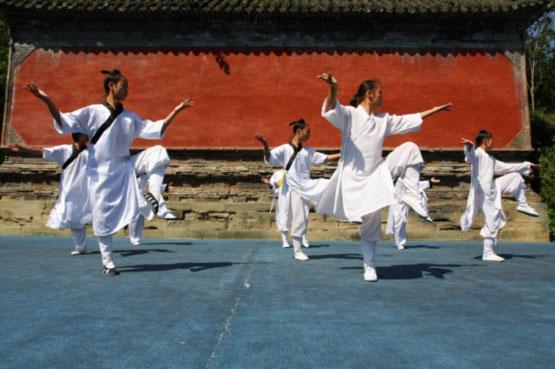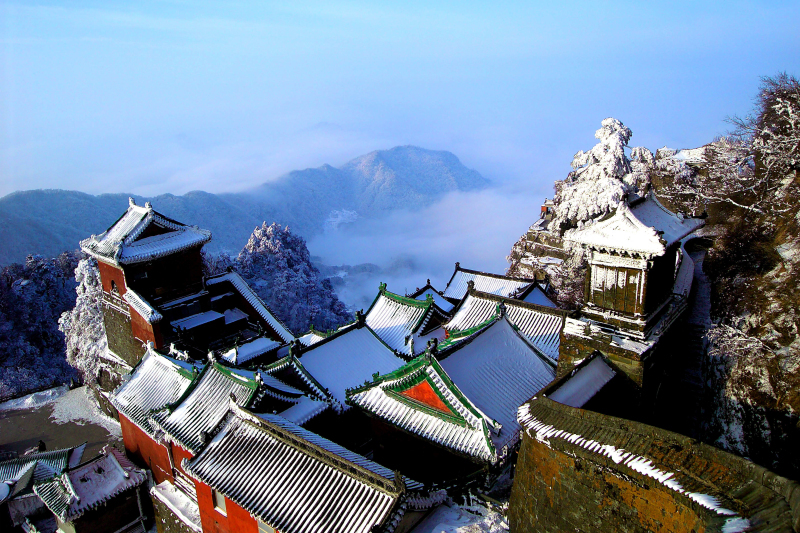What is Wudang Kungfu?
Wudang Kungfu refers explicitly to the boxing school with the Taoism inner alchemic exercises created by the famous Wudang Taoist ancestor Zhang Sanfeng. It was created on Wudang Mountain in south China by integrating the folk culture and Taoist ideas. Attributing to the Taoist disciples, the martial art was brought to ordinary people and, because it originated in Wudang Mountain, people call it the Wudang Kungfu. Later, Wudang Kungfu grew to be very famous, even comparing to Shaolin Kungfu in north China. Therefore, people refer to those two kinds of martial arts together as Southern Wudang and Northern Shaolin.
Zhang Sanfeng (1247 - 1464) is a Taoist priest from the late Southern Song Dynasty (1127-1279) to the early Ming Dynasty (1368 -1644). According to the Taoist legends, Zhang Sanfeng pursued Taoism monasticism on Wudang Mountain in Hubei province. Based on the Taoism beliefs; he created the Wudang martial art. The records of Ming Dynasty History “Fangji Zhuan” (Biographies of Magicians and Diviners) reveal that Zhang Sanfeng lived on Wudang Mountain and was resurrected in Baoji, Shaanxi. Later, Taizu Zhu Yuanzhang and Chengzu Zhu Di of the Ming Dynasty sent people to find him, but there was no luck.

Zhang Sanfeng spent all his life familiarizing all the concepts of Confucianism, Buddhism, and Taoism, and he mainly investigated science. He believed that doing good is much more important than the specific religion people believe in. He thought that the common sense of the three biggest religions lies in the Dao, which helps others by cultivating oneself. Therefore, Zhang Sanfeng combined Taoism's inner cultivation ideas with the self-cultivation of Confucianism to achieve both inner satisfaction and exterior cultivation.
Emperor Yingzong of the Ming Dynasty conferred Zhang Sanfeng the title Perfect Manifestation of Pervasive Subtlety" ( 通微显化真人 Tongwei Xianhua Zhenren ) in 1459.
Emperor Xianzong of the Ming Dynasty granted him the title 'Brilliant and Lofty Perfect Immortal' ( 韬光尚志真人 Taoguang Shangzhi ) in 1486.
In 1623, Emperor Xizong of Ming Dynasty offered Zhang Sanfeng him the title Perfect Flying Dragon Sovereign Who Manifests Salvation, Promotes Benevolence, and Benefits the World" ( 飞龙仙化宏仁济世真君 Feilong Xianhua Hongren Jishi Zhenjun).
As mentioned before, the Wudang Kungfu was founded by Zhang Sanfeng in the Southern Song Dynasty. After hundreds of years of development, Wudang martial art was evolved into many small schools like Tai Chi Boxing, Baguazhang, Xingyi Boxing, Wudang Swordsmanship, Xuanwu Cudgel, Sanhe Knife, and many others, and the Wudang Kungfu has become a complete martial art system with rich theory foundations.
Besides Zhang Sanfeng, the Wudang Kungfu master Huang Baijia from the late Ming Dynasty (1368 - 1644) and early Qing Dynasty (1644 - 1912) was also very famous; he specialized in Wudang Tai Chi Boxing. In contrast, the Kungfu master Gan Fengchi during Emperor Qianlong's reign mastered all the martial arts and excelled at both the inner and external works. His internal boxing was succeeded by Ma Yuncheng in Luoyang, who helped spread the Wudang inner exercises and had many disciples like Song Yiming, Bi Chengxia, and Guo Jiyuan. Bi Chengxia secluded himself in Jiuhua Mountain in Anhui, while Guo Jiyuan remained in Wudang Mountain.
Song Yiming had some disciples, in which Song Weiyi and Chen Shijun were very famous. They both excel at Wudang Swordsmanship, and their famous followers are Zhang Xiangwu, Li Jinglin, Guo Xifeng, and Zhou Hanmin. In 1930, a group of Japanese Kendo masters came to China and had a sword duel with master Zhou Hanmin, making the Wudang martial art more popular throughout the country. At the Berlin Olympics in 1936, a group of Chinese Martial Art delegations performed the "Wudang Swordsmanship," which made the Wudang Kungfu renown overseas.
As the Wudang Kungfu was brought to Shaanxi first and then to Zhejiang, some pithy formulas of Wudang Kungfu contain the northern dialects.

Wudang Tai Chi refers to the Tai Chi boxing that integrates the thinking of the changes of Yin and Yang and five elements in I-ching, the meridian science, guiding technique, and the expiration and inspiration in traditional Chinese medicine in the basis of the core concepts of conventional Chinese Confucianism, Taiji Philosophy in Taoism, and the dialectical theory of Yin and Yang to achieve the results of edifying temperament, keeping healthy, and self-defense. It’s one of the pillar schools of Wudang martial arts.
Xing Yi Quan is one of the internal styles of Wudang martial arts. It’s characterized by aggressive, seemingly linear movements and explosive power applied from a close range. Therefore, Xing Yi Quan is suitable for military fights where no gaudy exercise can survive but the soldiers with actual Kungfu like Xing Yi Quan.
Baguazhang is one of the famous internal styles of Wudang martial arts based on the I-ching Bagua theories. As a manifestation of Taoist health, fitness, and self-defense, Baguazhang emphasizes palm switching skills and walking movements.
At the beginning of the 21st century, Zhong Yunlong, the head of Wudang martial arts, trained many Wudang disciples and among whom Yuan Shimao, Chen Shixing, and Chen Shiyu were the outstanding ones. They together broadened the influence of Wudang martial art. Chen Shixing, exceptionally skilled in dodging, continued to teach Wu Dang in Wuhan and Shanghai.
In 2004, Yuan Shimao founded the Kungfu center and taught the disciples about the Wudang Kungfu. In 2007, a young man named Dai Qianyu was trained under Chen Shixing and pioneered the Swordsmen Kungfu Club and further promoted the Wudang kungfu to ordinary people.
First of all, Taoist philosophy is not a theory specially created for Wudang Kungfu. Instead, the Wudang Wushu is created by Taoist masters to adapt to the Taoist practice. Therefore, Wudang Kungfu is designed for Taoism practice. The Taoism thinking of Yin and Yang, Dao (principle) in the universe, Bagua, and Five Elements can make the Wudang Kungfu more conducive for the human body.
Wudang Kungfu and Shaolin Kungfu are two of the most famous martial arts in China. They stemmed from different ideologies, and they have different purposes. The Wudang Kungfu focuses more on internal health, while the Shaolin Kungfu focuses more on external health. Each has its advantage, and it’s hard to say which one is better.
Wudang martial art is created by Taoist masters who emphasize more physical health than the pursuit of Kung Fu itself. This is why the Wudang boxing often have smooth moves, and they like to take a quiet and soft approach and tend to dodge during the fighting.
Shaolin Kungfu is famous for its short and ingenious movements. Most boxing routines contain 36 actions, often performed very fast, and every compact is tightly correlated. The entire exercise takes a short period so that the practitioners can concentrate on the whole body's energy. Besides, the movements of the Shaolin Kungfu are all-powerful. Practicing Shaolin Kungfu is more of Kungfu pursuing and body strengthening to understand the power of Zen.

Wudang Mountain is a famous Taoism mountain and the birthplace of Wudang martial art. It has been a place for religious activities since the Wei, Jin, and Northern Southern Dynasties (220 - 577). In the Tang Dynasty, the Five Dragon Temple was built, and by the end of the Tang Dynasty, Wudang Mountain was listed as one of the seventy-two holy places for Taoists. In Song and Yuan Dynasties, Wudang Mountain was entitled "Taiyue" and revered as the "Private Temple for Imperial Families." Since then, Wudang Mountain became the No.1 Taoism mountain and the biggest place for Taoist rites.
The Taoism buildings on the Wudang Mountain were mostly constructed in the Tang Dynasty and restored and expanded in Song and Yuan Dynasties. It was in Ming Dynasty that the architectural restoration of the Wudang mountain reached the prime times. Chengzu Emperor of the Ming Dynasty ordered people to perform a big scale of repair and expansion. After 14 years of construction and the cost of a great fortune, a complete architectural system of 9 palaces, 8 Taoist temples, and 16 buildings and halls was finally completed. In later generations, those buildings were restored and extended. Nowadays, there are 53 ancient architectures, nine architectural sites, and over 7400 pieces of cultural relics existing on Wudang Mountain.
Copyright © 2019 Lily Sun China Tours International, Inc. Terms &conditions | Privacy Policy | Sitemap